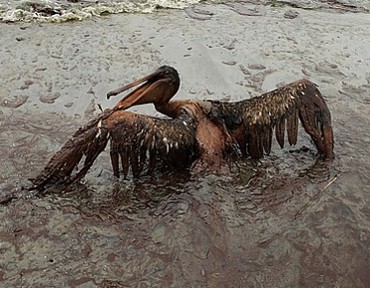It’s now exactly one year to the month since BP’s Deepwater Horizon offshore rig exploded - killing 11 people and releasing oil into the Gulf of Mexico for nearly three months, until mid-July.
 Pelican covered in oil soon after the BP disaster. Image credit: Lord Mariser (Flicker CC).
Pelican covered in oil soon after the BP disaster. Image credit: Lord Mariser (Flicker CC).
At the time, the U.S. Geological Society estimated that the rig was gushing out crude oil at a rate of 12,000 to 25,000 barrels per day, spewing out a total of about 4.9 million barrels (206 million gallons) by the time the well was sealed.
Many politicians called it the worst environmental disaster in the nation’s history, doing massive damage to the region’s ecosystems, though the National Oceanic and Atmospheric Administration (NOAA) did tests that gave a more optimistic view.
The same month that the well was sealed, NOAA began testing the sea life for pollutants, declaring the seafood safe to eat, and reopening the Gulf waters.
Trying to further reassure the public, Dr. Margaret Hamburg, commissioner of the U.S. Food and Drug Administration, said in a statement, “We need the American public to be confident in the seafood coming from the Gulf, and the testing that has been done has not indicated any level of concerns.”
Those words didn’t do too much to calm public concerns about Gulf seafood and NOAA has found it necessary to continue to test the sea life to reassure the public that it’s safe to eat.
Last week, NOAA announced that it was continuing to “re-test the seafood from the Gulf of Mexico to demonstrate to Americans and to worldwide consumers that it is safe to eat” and that this re-testing will continue into the summer.
 Gulf of Mexico fishing and recreational graphic map. Courtesy of gulf-of-mexico.com.
Gulf of Mexico fishing and recreational graphic map. Courtesy of gulf-of-mexico.com.
We are continuing to test and we are making the data available to the public, so they can make fully informed decisions. Gulf seafood is consistently passing the FDA’s safety tests by a wide margin,” said Eric Schwaab, assistant NOAA administrator in charge of the agency’s fisheries service.
These tests are being carried out in reopened Gulf waters covering nearly 88,000 square miles, sampling fish that are considered commercially and recreationally important, such as grouper, snapper, tuna, and mahi mahi.
What is still considered a risk zone is the over 1,000 square miles of water immediately surrounding the former wellhead. This area remains closed to all commercial and recreational fishing. NOAA has already started sampling the closed area and says that it will reopen the area if all the samples pass physical and chemical inspections.
Reader comments and input are always welcomed!